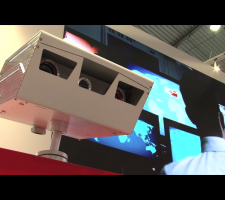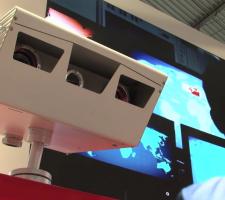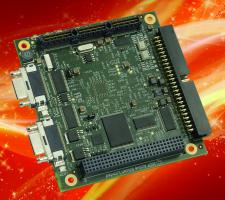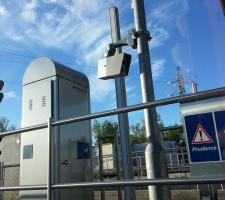
Colin Sowman reviews some of the traffic-related exhibits at the 2014 Vision Show in Stuttgart.
Traffic was a major theme at this years’
Making a major impact at the show was Tattile which is in the unusual position of providing complete camera systems for traffic monitoring, tolling and enforcement as well as supplying the industrial side of the market. According to its CEO Corrado Franchi: “There is a close synergy between the two industries as traffic utilises the same technology as the industrial sector and all the implementation done in the industrial division can be used, for instance, in plate reading for ANPR systems.
“There is definitely a close relationship between the two and we have the advantage of having both technologies,” said Franchi.
Currently the company is focussing on mobile plate reading for police applications which come with embedded technology so all the image processing is done within the camera itself. The camera features ‘plug & play’ installation and can also be used as a stand-alone application with events saved on an embedded micro SD.
Celebrating 25 years in the machine vision business was camera manufacturer Allied Vision (AV) which was highlighting its partnership approach to the various sectors – including traffic. “We don’t just sell cameras and technology, we engage onto an in-depth partnership with industry sectors including traffic to help them provide design solutions,” said corporate marketing manager Jean-Philippe Roman.
AV’s technology is used for open road tolling as well as speed and red light enforcement by companies like
Advice for authorities looking to replace and update their traffic cameras from
As an example he points to the latest large sensor cameras such as the LT16059 on display which has a 16 megapixel CCD sensor with up to 82dB dynamic range and a global shutter for sharp images under all lighting conditions. The camera comes with USB 3.0 connection (as well as Ethernet and GigE) for ease of integration and high data transfer rates.
Perhaps the most striking indication of the increasing influence of machine vision to the traffic sector, and vice-versa, is the introduction of hardware specifically tailored to the rigours of roadside applications. One example is
The VCSBC F boards are based on Freescale’s quad-core processor which greatly increases the ability to process images in multiple ways and in real time. This allows optimised ANPR software to run on the embedded platform rather than on a separate PC. “There’s no need for an external pc – the system is entirely stand-alone,” said the company’s Jan-Erik Schmitt.
The new board is designed to accept two cameras to enable both colour contextual images and infrared monochrome images for the ANPR to be captured simultaneously. However as the processing is done by the embedded system the amount of information sent through the network is substantially reduced. “Instead of sending 25 or 30 frames per second whereas we would send perhaps one when an offence has been committed,” said Schmitt.
For its part
These lenses are designed for use with sensors up to 25mm (one inch) in size and come in a range of fixed focal lengths of 12mm, 16mm, 25mm, 35mm and 50mm. They have a lockable focus ring and while this design precludes pan/tilt/zoom operations, according to Qioptiq director Thomas Schäffler, it makes for a more robust construction because, effectively, there are no moving parts. This approach extends to the fixed aperture design (f1.6 or f1.8), the housing, and glass retention system.
The C versions of the lenses have an adjustable and lockable iris and lockable focus ring while the CM version is motorised and comes with automatic focussing and iris control for fully remote applications.
While not currently used in traffic–related applications Qioptiq also demonstrated a liquid lens designed for use with 6mm (1/4 inch) sensors which can focus in a few milliseconds.
According to Schäffler it could be utilised in low light speed enforcement as the lens could refocus between taking the two images. This means capturing sharp images of a speeding vehicle in two positions would not rely on the small (light restricting) aperture required to achieve the depth of field needed to do the job with a fixed focus lens.
On the JAI stand was its 4th generation ITS camera package, the Viscam 1000, which comprises a camera and lens, illumination and image processing all mounted in a ‘sandwich’ housing.
The double skinned upper half effectively shades the top of the inner housing to minimise heat build-up and means a cooling fan is not required. The lower part of the housing has a dirt guard which removes the need for a wiper, so there are no moving parts in the housing construction.
Running at 72 frames per second and with built-in video triggering, the five megapixel CMOS camera can operate between -45° and +70° and comes with on-axis lighting (near infrared, white or blue) and can be connected to an external lighting source if required.
Gardasoft used the Vision Show for the first public showing of its Triniti Technology system, which is designed to simplify the connection and synchronisation of cameras, lighting and other auxiliary systems. Company director Peter Bhagat said Triniti has been developed for machine vison applications and makes set-up and operation much easier and provides a far greater degree of system integration.
While the system has initially been introduced for industrial applications, he expects it will find applications in the traffic sector very soon. Gardasoft is already offering GigE protocol versions of its LED strobe lighting modules that connect directly into many widely-used image processing packages.
“It’s going to be a game-changer and will remove the need for CCD sensors,” said Basler’s market manager Enzio Scheider. “This will allow the development of very price competitive products for the traffic market such as ANPR or similar.”
The capturing and transmission of relevant images from standard analogue and Camera Link serial communication protocol video can be done using the latest frame grabbers from
Looking to exploit the full capability of
In ANPR applications the sensor is used to simultaneously capture numberplate details, contextual images and visual evidence of the driver from a single frame. In processing up to12dB of gain is used on the darker parts of the image (such as the driver’s face) without, it is said, problematic noise degradation. The USB 3.0 mvBlueFOX3 version is capable of 162 frames per second.
Other transportation systems were also catered for at the show and the
On Semiconductor exhibited its Python series cameras which offer up to 100 frames per second and resolutions between 0.3 and 25 megapixels. For traffic applications product manager Joost Seijneve highlighted the five megapixel version which has eight outputs and a global shutter said to be 99.987% efficient. He highlights the relevance of this to the traffic market because it enables high dynamic range images to be captured of fast moving objects. Wide format versions can capture several number plates simultaneously in multilane applications.
Canadian camera producer
So it seems the machine vision industry really is becoming aware of the traffic sector’s needs.
Traffic take-up
That the traffic sector is beginning to take a serious interest in the capabilities of machine vision was evident to
Multiple regions of interest can be captured simultaneously from a single image; allowing only the parts of relevant frames to be transmitted to the control room and so minimising bandwidth requirements. In addition, Romero said the camera is programmed to take advantage of the wider dynamic range of the latest generation of sensors with on-chip image processing and photo correction which reduces the overall bandwidth requirement by up to 95%.
Spotting danger
When a vehicle carrying dangerous goods is identified, the cameras send an alert to a variable message sign by, for instance, the entrance of the tunnel, to alert the driver to continue only if permitted, or turn back. The vehicle can also be tracked throughout the tunnel using a series of cameras, ensuring the authorities are aware of any incident instantly and precautions can be taken.















